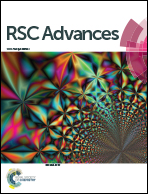Application of magnetic Cd2+ ion-imprinted mesoporous organosilica nanocomposites for mineral wastewater treatment
Abstract
This work demonstrates a simple strategy for producing highly selective adsorption magnetic ion imprinted mesoporous silica (MIIMS) nanocomposites. They have been functionalized by a γ-(aminoethylamino)propyl chelating group for specific recognition and rapid removal of toxic heavy metal ions from wastewaters. The superparamagnetic Fe3O4 nanocrystal was encapsulated in an imprinted mesoporous organosilica shell via a co-condensation synthesis method. The results of transmission electron microscopy (TEM) and small angle X-ray diffraction (XRD) confirmed that the imprinted mesoporous organosilica shell preserved a highly ordered 2D mesostructure. The Brunauer–Emmett–Teller (BET) analysis found the surface area was 946 m2 g−1. The saturated adsorption capacity of MIIMS toward cadmium reached up to 25.2 mg g−1 (0.224 mmol g−1) at pH 5.0. The adsorption of cadmium reached an equilibrium within 4.5 min. The results of a selectivity study revealed that the adsorption capacity for Cd2+ is much high than other co-existing heavy metal ions. The adsorption efficiency of MIIMS was above 94.2% after six extraction-stripping cycles. The MIIMS can efficiently remove cadmium ions in water treatment applications.



 Please wait while we load your content...
Please wait while we load your content...